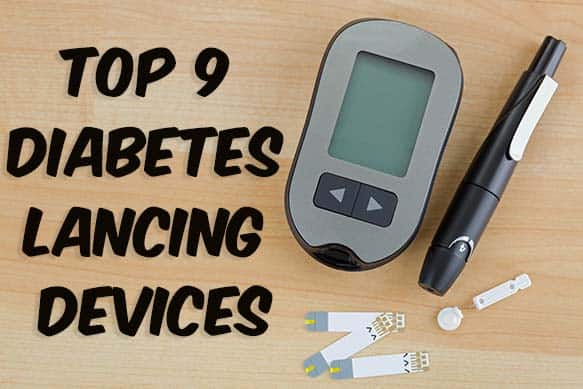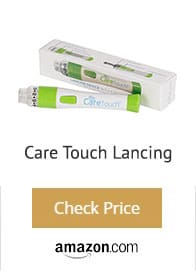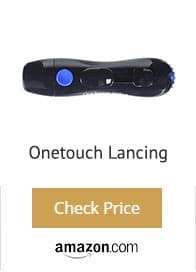
Ensuring you keep your blood glucose levels well within your target range, is one of the most common goals for those with diabetes. You simply cannot monitor your blood glucose levels without using a lancing device that pricks your finger and allows you to measure using a drop of blood.
While diabetes management can be challenging and at times overwhelming, determining which types of supplies and products to use should not be. With so many different products on the market you can begin to feel like there is no right answer on which you should be using.
In this review, we’ll discuss the available types of lancing devices, their benefits and why they might be the best fit for you. Let’s take a look.
Contents
Care Touch Adjustable Lancing Device
The Care Touch Adjustable Lancing device is unique when compared to others on the market. It offers 10 adjustable depths to ensure you can get the blood sample you need. An included ejector button pushes out the lancet after it has been used so that you can replace it with a new one. It is compatible with most round types of lancets. Advanced technology offers precise delivery which allows for a less painful testing and a smaller blood sample.
Click here to learn more.
Bayer’s Microlet 2 Adjustable Lancing Device
The Bayer Microlet Adjustable device gives you a comfort grip so that you can easily check your blood glucose whenever necessary. With five adjustable setting depths for your fingers. An easy grip gives you a precise and easy aim for smoother lancing. The ergonomic design means you will endure less painful testing with smaller blood samples for much easier testing.
Click here to learn more.
I suggest reading the following articles:
Accu Chek Fast Clix Lancing Device
The Accu Chek FastClix lancing device is the only lancing device that features 1 click testing. The lancets for the FastClix are conveniently stored in an easy to replace drum. This means you do not have to individually load your lancets one by one when its time to replace them. Instead, each drum stores up to 5 lancets, making it easier to test and requires lest changes. Because let’s face it, changing your lancet is something that those with diabetes don’t do as often as they would like. So here’s an easy and affordable solution to making sure you make these changes on a more frequent basis.
Click here to learn more.
OneTouch Delica Lancing Device
The LifeScan OneTouch Delica is considered to be one of the most delicate lancing the devices on the market. It offers a thinner and shorter lancing need but still allows for an adequate amount of blood for testing to be drawn. The uniquely designed advanced glide control system provides a reduction in vibration for a much smoother lancing system. The ejection button provides you with a safe way to remove used lancets so you don’t have to risk an accidental prick. There are 7 depth settings that allow you to choose the right depth for the most comfortable testing.
Click here to learn more.
Accu-Chek Soft Clix Lancing Device
The Accu-Chek Softclix lancing device was designed to be less painful with more ease of use. Created specifically for customized comfort levels to help minimize any pain or discomfort you may feel during testing. There are 11 different depth settings that allow you to choose a level that works best for you. The unique comfort design helps to reduce damage to your skin, creating less scar tissue. The lancing device can be used either detached or attached from the meter. The Softclix works with 28 gauge lancets to provide a penetration range from 0.8 to 2.3mm, allowing you to get the right amount of blood for testing each time.
Click here to learn more.
Freestyle Lancing Device
The Freestyle Lancing Device comes with Freestyle brand meters, or it may be purchased separately. It is easy to use and provides you with minimal pain from testing. Personally designed with their own comfort zone technology to help reduce pain. The adjustable settings for depth provide you with a more individualized need for testing. The Freestyle Device is used with Freestyle Lancets which are ultra-thin, stainless steel 28 gauge needles. They are designed to create a more comfortable testing experience. Remember to test properly by following the instructions in the manual of the product.
Click here to learn more.
Genteel Lancing Device
The Genteel we’ve covered before, but it’s definitely one that should be included in the top lancing devices. While it’s new on the market, it’s definitely making a huge name for itself in a good way. It uses custom vacuum technology that is able to draw up the blood for testing. You don’t have to worry about squeezing and adding extra pain. You can also use the Genteel on alternative testing sites on the body. This will help save those fingertips from developing scar tissue like crazy. With the precise depth control feature you can choose from 6 different levels to get just the right depth. The Genteel is the only device that is FDA approved for alternative site testing. It can be used for children and adults with Type 1, Type 2, gestational and prediabetes. It also is compatible with many different types of lancets, making it easier and more affordable than most others on the market.
Click here to learn more.
Further reading:
On Call Stealth Lancing Device
The On Call Stealth Lancing Device was created to provide you with the maximum comfort possible. It includes 11 different depth settings which allow you to use alternative sites such as your forearm and palm to test. The yellow button helps to show you when the lancing device is ready to use. There is even an included lancet ejector to help you avoid any accidental needle pokes when removing a used lancet.
Click here to learn more.
FORA Safety Lancets
The FORA safety lancets were designed for one time use and do not require a lancing device to use them. They feature a 30 gauge 1.8mm depth lancet in an enclosed device. Each lancet is sterile and allows you to easily test anywhere, even when you are on the go. You don’t have to worry about changing and replacing the lancet with a new one each time. Instead test, and toss away and grab another when the time comes to test again.
TheDiabetesCouncil Article | Reviewed by Dr. Christine Traxler MD on June 02, 2020
Click here to learn more.














